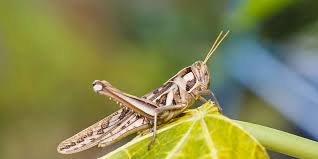
The locust control operations have been done in 1,76,055 hectares area in states of Rajasthan, Madhya Pradesh, Punjab, Gujarat, Uttar Pradesh and Haryana by Locust Circle Offices (LCOs) from 11th April 2020 to 16th July 2020. Till 16th July 2020, control operations have been done in 1,76,026 hectares area in states of Rajasthan, Madhya Pradesh, Punjab, Gujarat, Uttar Pradesh, Maharashtra, Chhattisgarh, Haryana and Bihar by State Governments.
Daily Current Affairs Quiz 2020
Key-Points
The Desert locusts (Schistocerca gregaria) is one of about a dozen species of short-horned grasshoppers (Acridoidea).
For laying eggs, they require bare ground, which is rarely found in areas with dense vegetation. So, they can breed in Rajasthan but not in the Indo-Gangetic plains or Godavari and Cauvery delta.
During quiet periods, known as recessions, Desert Locusts are usually found only in the semi-arid and arid deserts of Africa, the Near East and South-West Asia that receive less than 200 mm of rain annually.
When weather and habitat conditions are right for reproduction, multiple generations of locusts can be born and form swarms that invade countries that don’t usually have locust problems.
The swarms can be anything from under one km2 to several hundred km2. There can be from 40 million to 80 million adult locusts in each square kilometre of a swarm.
Desert Locusts usually fly with the wind at a speed of about 16-19 km/h. Swarms take off about 2 hours after sunrise, fly during the day, and settle just before sunset. They can travel up to 130 to 150km or more in a day.
Harm from locusts
Desert Locusts are polyphagous and feed on leaves, shoots, flowers, fruit, seeds, stems and bark. They can eat massive quantities of vegetation – wild plants, shrubs, trees and grass. This can badly erode the food security of communities.
Locusts do not attack people or animals. There is no evidence to suggest that they carry diseases that could harm humans.
Locusts control methods
There are three types of commonly accepted standard practices in locust control: (1) Conventional pesticides, (2) Biopesticides and (3) Insect growth regulators. The primary method of controlling them is with mainly organophosphate chemicals applied in small concentrated doses, referred to as ultra-low volume (ULV) formulation.





